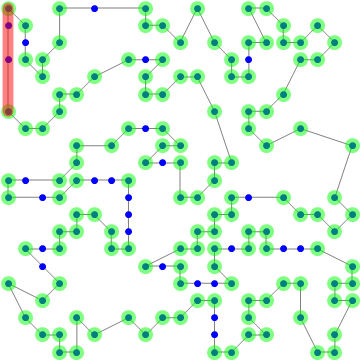Update: The function in the original answer does not work for arbitrary polygons. The following seems to work
ClearAll[nonCollinearHull]
nonCollinearHull = Module[{coords = #,
angles = ArcTan @@@ (Subtract @@@ Partition[#, 2, 1 , {1, 1}]),
rotation, lengths},
rotation = LengthWhile[Reverse[angles], # == angles[[1]] &];
lengths = Length /@ Split[RotateRight[angles, rotation]];
TakeList[RotateRight[coords, rotation], lengths][[All, 1]]] &;
Examples:
coord = {{0, 0}, {10, 0}, {20, 0}, {30, 0}, {25, 10}, {0, 10}, {0, 5}};
lines = Line /@ Partition[nonCollinearHull[coord], 2, 1];
longest = Last@SortBy[lines, N@ArcLength[#] &];
Graphics[{EdgeForm[Gray], FaceForm[], Polygon@coord, Blue,
PointSize[Large], Point@coord, Opacity[.5, Green],
AbsolutePointSize[15], Point[nonCollinearHull[coord]],
Thickness[.03], CapForm["Round"], Opacity[.5], Red, longest}]

Using
SeedRandom[123]
coord2 = DeleteDuplicates[#[[FindShortestTour[#][[2]]]] & @
DeleteDuplicates@RandomInteger[10, {50, 2}];
we get

And with
SeedRandom[123]
coord3 = DeleteDuplicates[#[[FindShortestTour[#][[2]]]] &@
DeleteDuplicates@RandomInteger[20, {200, 2}]];

Alternatively, you can use MaximalBy to define longest:
SeedRandom[777777]
coord = MapIndexed[{#2[[1]], #} &, Accumulate[RandomInteger[{-2, 2}, 50]]];
lines = Line /@ Partition[nonCollinearHull[coord], 2, 1];
longest = MaximalBy[lines, N@ArcLength[#] &];
Graphics[{EdgeForm[Gray], FaceForm[], Line@coord, Blue,
PointSize[Large], Point@coord, Opacity[.5, Green],
AbsolutePointSize[15], Point[nonCollinearHull[coord]],
Thickness[.03], CapForm["Round"], Opacity[.5], Red, longest}]

Original answer:
Using the function noncollinearF from this answer:
ClearAll[noncollinearF]
noncollinearF[verts_] := Function[{k}, Nor @@ (RegionMember[ConvexHullMesh[#], k] & /@
Subsets[Complement[verts, {k}], {2}])]
lines = Line /@ Partition[Pick[#, noncollinearF[#] /@ #], 2, 1, {1, 1}]& @ coord;
longest = Last@SortBy[lines, N@ArcLength[#] &];
Graphics[{EdgeForm[Gray], FaceForm[], Polygon@coord,
Blue, PointSize[Large], Point@coord,
Thickness[.03], CapForm["Round"], Opacity[.5], Red, longest}]







